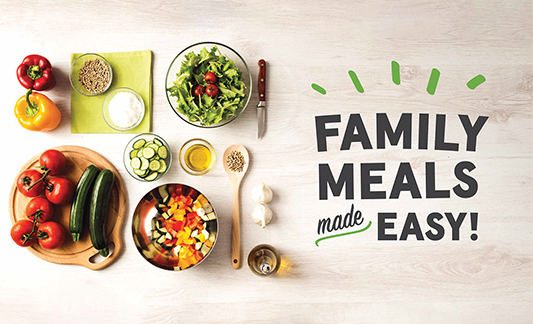Help Isom IGA recover from devasting floods

5 min read
Why Family Meals Represent A Growing Opportunity for Independent Grocers
Written by IGA News
Sep 3, 2025
As September ushers in National Family Meals Month, new insights from FMI’s U.S. Grocery Shopper Trends 2025: New Routines highlight the central role family meals continue to play in American households. The report offers encouraging signs for independent grocers, as families are increasingly prioritizing meals at home, creating fresh opportunities to support shoppers with solutions that blend nutrition, convenience, and togetherness.
Keep reading for a breakdown of these new routines anchored around family meals and how they apply to independents.
Family Meals as a Social and Nutritional Anchor
One of the report’s strongest messages is that eating together matters. 90% of shoppers say eating at home with their household is at least somewhat important, with nearly two-thirds (64%) eating dinner together at least a few times a week. As FMI notes, “Dinner remains the centerpiece of shoppers’ eating routines, with a focus on taste, socializing, and enjoyment.”
The act of sitting down together provides more than just nourishment; it builds bonds, and families are using dinner as a way to connect. Among regular dinner-eaters, 63% enjoy meals with others four or more times a week, while 43% follow at least one weekly dinner tradition, such as Taco Tuesday or Pizza Friday, that eases meal planning and fosters household rituals.
As the report emphasizes, these traditions are not about elaborate cooking but about “relatively low cooking involvement and high crowd-pleasing” meals.
How independent grocers can help shoppers:
- Promote Weekly Meal Traditions
Create endcaps or promotions around simple, crowd-pleasing dishes like tacos, pasta, or pizza. Consider offering “Family Night Bundles” that include all the essentials for a themed meal.
- Support Affordable Meal Prep
Highlight value-driven options by pairing private-label items with fresh produce and proteins. Feature recipes that show how to create nutritious, filling family meals at a reasonable cost.
- Celebrate Togetherness in Marketing
Use messaging that reinforces the emotional benefits of eating together. Feature customer stories or local families in campaigns to tie family meals to community pride.
This month, promote IGA's Celebrate Family Meals Month Sweepstakes, which offers shoppers a chance to win $500 in grocery gift cards. Click the link for promotional assets, encourage shoppers to subscribe to the Recipe Club eNewsletter, and share this shopper solutions blog, Celebrate National Family Meals Month: Why Gathering at the Table Matters.
 Add the above image to your website for the month of September to promote Family Meals Month and encourage shoppers to enter the sweepstakes.
Add the above image to your website for the month of September to promote Family Meals Month and encourage shoppers to enter the sweepstakes.
Parents Lead the Charge on Shared Meals
Parents are at the heart of this trend. The report reveals that 77% of parents consider eating at home with their household extremely or very important. They are also more likely to maintain weekly meal traditions, with 70% reporting at least one recurring dish night, underscoring how family meals provide stability amid the busy rhythms of school and work.
At the same time, parents face sharper challenges. They remain highly concerned about grocery prices — 73% are extremely or very concerned, compared to 66% of all shoppers — but still express greater confidence in managing household expenses.
This balancing act highlights an opportunity for grocers to provide affordable yet convenient meal solutions that ease both financial and time pressures. In addition to the above suggestions, independents can support shoppers by:
- Offering Meal Planning Resources
Provide printed or digital weekly meal plans, making it easy for busy families to incorporate shared dinners into their schedules.
 Point shoppers to iga.com/recipes to sign up for the Recipe Club eNewsletter.
Point shoppers to iga.com/recipes to sign up for the Recipe Club eNewsletter.
Fall Brings a Shift Back to the Dinner Table
The transition from summer to fall amplifies the importance of family meals. According to FMI, 69% of shoppers plan to make at least one change to their eating habits this fall.
The most common adjustments?
- 41% plan to prepare more meals at home
- 34% plan to eat dinner at consistent times
- 32% plan to share dinner at home with others more often
For parents especially, fall means not just dinner but also school lunches. The study found that 75% of parents plan to send their children to school with lunches from home, a significant increase from 2024. Reasons range from health and nutrition (48%) to taste preference (45%) and cost savings (36%).
For grocers, this creates a dual opportunity: support families in stocking up for nightly dinners while also providing practical, packable options for school lunches.
- Ease the Lunchbox Crunch
With 75% of parents sending lunches from home, provide grab-and-go packs of fruits, veggies, proteins, and whole grains. Position these as both nutritious and time-saving.
Value and Convenience Remain Key
Even with the cultural importance of family meals, shoppers remain sensitive to price. Two-thirds (66%) are extremely or very concerned about retail food prices, and 82% see getting good value as a top priority.
Parents, in particular, are asking for more convenient solutions to help balance busy schedules.
When asked how retailers could make meal prep easier, shoppers’ top request was better value options (45%), followed by easy-to-prep foods (37%), and ready-to-eat meals (29%).
These findings suggest that families want to keep mealtime rituals alive but need accessible solutions to make them work within modern pressures. Again, independents can help families achieve these goals by promoting weekly meal traditions through recipes and meal-solution endcaps and highlighting value and ready-to-eat options.
 Geissler's Supermarkets use Family Meals Made Easy wobblers to call attention to their ready-to-eat meals.
Geissler's Supermarkets use Family Meals Made Easy wobblers to call attention to their ready-to-eat meals.
As FMI’s U.S. Grocery Shopper Trends 2025 report makes clear, family meals remain a cornerstone of American life. In a climate where shoppers juggle concerns about prices, convenience, and time, the shared dinner table continues to symbolize comfort, connection, and care.
For independent grocers, this is more than a cultural observation — it’s a business opportunity. By leaning into family meal traditions, offering value-driven solutions, and positioning themselves as partners in mealtime, grocers can strengthen customer loyalty and play a central role in their communities.
Next Story
Institute Feature: Tomatoes →
You May Also Like
These Stories on Family Meals Month
Aug 28, 2025 1:11:58 PM |
2 min read
Sep 4, 2024 3:19:57 PM |
4 min read
Aug 12, 2020 4:04:01 PM |
2 min read




No Comments Yet
Let us know what you think